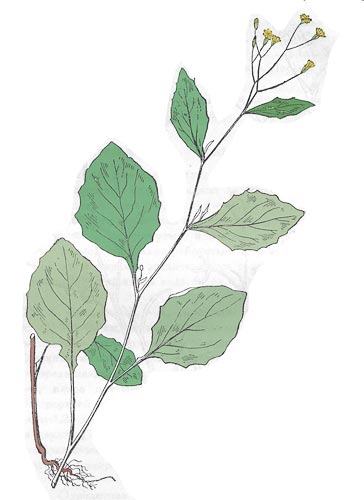Weeds
Lapsana communis L. - Common Nipplewort
Systematic position.
Family Asteraceae Dumort. (Compositae), genus Lapsana L.Biological group.
This species is an annual weed.Morphology and biology.
The root is stalky. Root system is well developed. Stalk is straight, simple or branchy, 20-100 cm in height, hollow, ridged from above, often reddish green, glabrous or pubescent in the lower part, with simple hairs or with an impurity of glandular hairs. Leaves are thin, soft, pubescent and dentate along margin. Phyllotaxy is alternate. The lower and middle stem-leaves are lyre-shaped and pinnatisected, with a large heart-shaped terminal lobe and 1-3 pairs of lateral lobes, decreasing in size toward base of petiole. Lower or middle leaves have a long petiole which is slightly winged and hairy. The upper leaves are fewer in number and smaller in size; they are usually lanceolate or narrowly ovate, sessile, lacking lobes of any kind. The plant terminates in a large spreading paniculate inflorescence with hairless branches. Flower heads are numerous, fine, up to 15 mm in diameter, each containing 8-20 yellow ligulate florets. Each ligulate flower ends with 5 small teeth. Anthers of stamen are long and brown, with a sagittate base. Receptacle is flat and bare. Involucre is campanulate or cylindrical, 2-4 mm wide and about 5-7 mm long, glabrous, biseriate. External leaflets short, ovoid, 3-5 in number. Internal leaflets long, oblong-linear, with a thick rib from above, 8-10 in number. External leaflets are 5-7 times shorter than internal ones. Achenes are brownish, 3-4 mm long, 1 mm wide, and 0.5 mm thick, glabrous, flat, slightly curved, narrowed toward both ends, with blunt tip. There are 20 thin small longitudinal costulae on surface of the achene. Pappus and rostellum are absent. The plant winters as a rosette of leaves, blossoming from June until September, reproducing by seeds. Some achenes drop in fields and litter the ground, some get into grains of cultivated plants. They are easily separated from grains. In dry conditions they maintain their germinating ability for six years. Unripe and mature achenes sprout at the same rate.Distribution.
This is a Euroasian forest species of the temperate climate zone, described from Western Europe. The general distribution includes the following areas: Europe, northern Iran, Northern Africa, the western Himalayas. This is an alien species in Northern America. In the former USSR it is distributed in the European part and the Caucasus. The species is occasionally found in the Southwest of Siberia (foothills of Altai) and in Central Asia (Kopet Dagh, vicinities of Almaty and Toshkent). It was brought to the Far East in the second half of 20th century.Ecology.
The plant grows in shady and humid places. In natural habitats the species is distributed in the forest zone in forests, on forests edges, along banks of water reservoirs. It is also found in ruderal places, i.e., along roads and fields, in fallow lands, in segetal habitats. It litters crops, fields, kitchen gardens, gardens, and parks. It is found in crops frequently, but not abundant.Economic significance.
Young leaves and stalks contain 84 mg/g (dry weight) or 16 mg/g (crude weight) of carotin, i.e., more than carrots. Five glycosides were identified in the latex of L. communis. Young plants can be used for salads and soups. The plant is also edible to cattle. The plant litters crops in the forest zone with a small abundance, to 2 points. It litters 1% of fields in northern taiga and 14% of fields in middle taiga and south to forest-steppe. Authors describe it as a widespread weed. This plant frequently litters winter crops and crops of perennial grasses, less often summer cultures.Control measures.
Do not contaminate sowing material or ground with seeds of the weed. Mow off or pull up the weed before fructification. It is necessary to remember that good results in the struggle against the weed can be only reached with a combination of agronomical and chemical methods.Referencve citations:
Keller B.A., Lyubimenko V.N., Maltsev A.I., Fedtshenko B.A., Shishkin B.K., Rodzevich R.Yu., Kamenskii K.V., eds. 1935. Weed plants of the USSR. V. 4. Moscow-Leningrad: AN USSR. 414 p. (In Russian)Shlyakova E.V. 1982. Keys to field weed plants of Non-Chernozem zone. Leningrad: Kolos. 208 pp. (In Russian)
Ulyanova T.N. 1998. Weed plants in flora of Russia and other FSU countries. Saint Peterburg: VIR. 233 pp. (In Russian)


